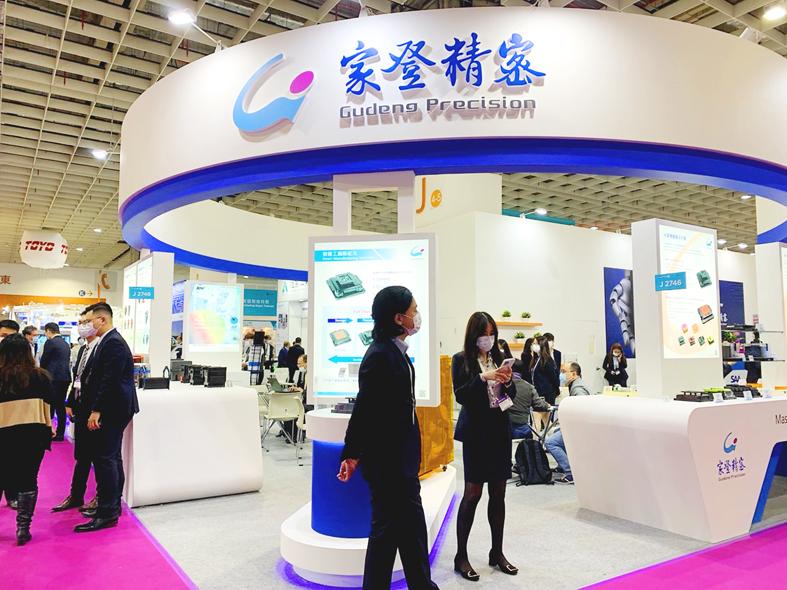Gudeng Precision Industrial Co (家登), the sole supplier of extreme ultraviolet (EUV) pods to Taiwan Semiconductor Manufacturing Co (TSMC, 台積電), yesterday said it is looking at setting up a factory in the US to align itself with TSMC’s capacity expansion there.
Gudeng is one of several TSMC suppliers that are considering following their customer in setting up operations in the US to provide on-site services.
TSMC is building a 12-inch fab in Phoenix, Arizona, for an initial investment of US$12 billion. It plans to produce 20,000 wafers a month using 5-nanometer technology when the fab becomes operational in 2024.

Photo: Grace Hung, Taipei Times
TSMC uses EUV tools extensively in the production of chips using 5-nanometer technology and plans to use it to make 3-nanometer chips.
Gudeng chairman Bill Chiu (邱銘乾) told a media briefing in Taipei that the company is in no hurry to build a plant in the US, given the small scale of TSMC’s capacity expansion in the US at this stage.
TSMC’s Arizona fab is to have installed capacity of 20,000 wafers a month, which is only one-fifth of 100,000 wafers at TSMC’s advanced factories at home.
“However, it is only a matter of time for Gudeng to build a presence in the US,” Chiu said, adding that semiconductor production has become a national security issue, which might constitute a trade barrier.
Building a localized supply chain, rather than cost efficiency, has become the top priority for semiconductor companies when selecting new factory sites, as the COVID-19 pandemic has upended the normal production and supply of components and raw materials, Chiu said.
“This [building localized supply chains] will be the top priority for us in the next three to five years,” he said.
Gudeng is looking to form an alliance with local semiconductor equipment manufacturers and raw material suppliers to minimize the risk of supply disruptions, Chiu said.
Before it builds capacity in the US, Gudeng is arranging several of its employees to work at its US office to provide on-site services to customers, Chiu said.
The employees are waiting for their working visa applications to be approved, he said.
Gudeng controls about 70 percent of the world’s EUV pod market, with TSMC and Intel Corp topping its customer list.
TSMC, Intel and Samsung Electronics Co are the world’s only three semiconductor companies that can afford the expensive EUV tools made by ASML Holding NV.
China is also trying to enter the advanced chip manufacturing market via Huawei Technologies Inc (華為), an industry insider said.
Huawei wants Gudeng to build a production line in China to back a chip manufacturing fab, the person said.
Gudeng yesterday gave an optimistic outlook for next year, thanks to strong demand for EUV pods and wafer front opening unified pods (FOUPs).
Gudeng said it has landed a big order to supply wafer FOUPs to the nation’s biggest semiconductor company next year and expects demand for EUV pods to rise rapidly after TSMC starts ramping up 3-nanometer technology in the second half of next year.
During the first 11 months of this year, Gudeng’s revenue surged 26.54 percent to NT$2.72 billion (US$98.24 million), compared with NT$2.15 billion in the same period last year.

Taiwan Semiconductor Manufacturing Co (TSMC, 台積電) last week recorded an increase in the number of shareholders to the highest in almost eight months, despite its share price falling 3.38 percent from the previous week, Taiwan Stock Exchange data released on Saturday showed. As of Friday, TSMC had 1.88 million shareholders, the most since the week of April 25 and an increase of 31,870 from the previous week, the data showed. The number of shareholders jumped despite a drop of NT$50 (US$1.59), or 3.38 percent, in TSMC’s share price from a week earlier to NT$1,430, as investors took profits from their earlier gains

In a high-security Shenzhen laboratory, Chinese scientists have built what Washington has spent years trying to prevent: a prototype of a machine capable of producing the cutting-edge semiconductor chips that power artificial intelligence (AI), smartphones and weapons central to Western military dominance, Reuters has learned. Completed early this year and undergoing testing, the prototype fills nearly an entire factory floor. It was built by a team of former engineers from Dutch semiconductor giant ASML who reverse-engineered the company’s extreme ultraviolet lithography (EUV) machines, according to two people with knowledge of the project. EUV machines sit at the heart of a technological Cold

Taiwan’s long-term economic competitiveness will hinge not only on national champions like Taiwan Semiconductor Manufacturing Co. (TSMC, 台積電) but also on the widespread adoption of artificial intelligence (AI) and other emerging technologies, a US-based scholar has said. At a lecture in Taipei on Tuesday, Jeffrey Ding, assistant professor of political science at the George Washington University and author of "Technology and the Rise of Great Powers," argued that historical experience shows that general-purpose technologies (GPTs) — such as electricity, computers and now AI — shape long-term economic advantages through their diffusion across the broader economy. "What really matters is not who pioneers

TAIWAN VALUE CHAIN: Foxtron is to fully own Luxgen following the transaction and it plans to launch a new electric model, the Foxtron Bria, in Taiwan next year Yulon Motor Co (裕隆汽車) yesterday said that its board of directors approved the disposal of its electric vehicle (EV) unit, Luxgen Motor Co (納智捷汽車), to Foxtron Vehicle Technologies Co (鴻華先進) for NT$787.6 million (US$24.98 million). Foxtron, a half-half joint venture between Yulon affiliate Hua-Chuang Automobile Information Technical Center Co (華創車電) and Hon Hai Precision Industry Co (鴻海精密), expects to wrap up the deal in the first quarter of next year. Foxtron would fully own Luxgen following the transaction, including five car distributing companies, outlets and all employees. The deal is subject to the approval of the Fair Trade Commission, Foxtron said. “Foxtron will be